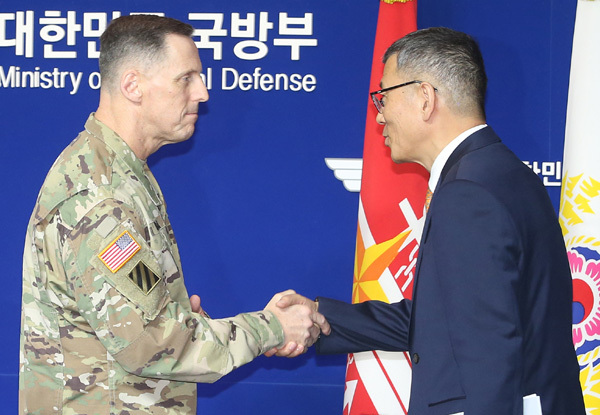South Korea and the United States have agreed to deploy a high-tech antiballistic-missile interception system in the Northeast Asian country to upgrade the allies' defense against North Korea's increasing nuclear and missile threats, the defense ministry said Friday.
The decision came after five months of negotiations between Seoul and Washington over whether to deploy the Terminal High Altitude Area Defense system, an advanced air defense shield that makes up the U.S.' mainland missile defense system.
 |
(Yonhap) |
The allies started the negotiations shortly after North Korea fired a long-range missile in early February in a defiant test of intercontinental ballistic missile technology after conducting its fourth nuclear test the previous month.
"South Korea and the U.S. have made the joint decision to deploy the THAAD system with U.S. Forces Korea as part of defensive action to guarantee the security of the Republic of Korea and our people from North Korea's nuclear weapons, weapons of mass destruction and ballistic missile threats," the Ministry of National Defense's deputy minister for policy Yoo Jeh-seung said in a press conference.
The deployment is also designed to secure the military power of the bilateral alliance, he said.
The allies' joint working group is currently in the final stages of proposing a site for the THAAD deployment to the countries' defense chiefs, Yoo said.
"South Korea and the U.S. are working closely together to deploy the THAAD system as soon as possible," according to the deputy minister.
When THAAD is deployed, it will not target countries other than North Korea and be exclusively used to deal with the communist country's nuclear and missile threats, Yoo said, brushing off China's protests raised over the deployment move.
"The deployment of THAAD will contribute to (the buildup of) a multi-layer missile defense and strengthen the South Korea-U.S. alliance's missile defense capabilities against North Korea's missile intimidation," the official also said.
Joining the announcement, USFK Chief of Staff Lt. Gen. Thomas Vandal said "Today's decision is a critical one in advancing the capabilities of the Republic of Korea and U.S. alliance as we work together to defend our alliance's military forces and people of South Korea from growing North Korean ballistic missile threats."
"North Korea's continued pursuit of missiles and weapons of mass destruction ... require our alliance to ensure we retain abilities to defend ourselves in the face of these threats, Vandal said.
The allies plan to announce the site for deployment "within a couple of weeks," Yoo said. But the specific location will not be made public due to operational secrets, he added.
Currently, about four counties are being cited as possible deployment sites including Pyeongtaek, south of Seoul, where USFK's new headquarters are based; Wonju, a eastern city close to the inter-Korean border; as well as the southern town of Chilgok.
"The allies aim to be able to start actually operating THAAD in South Korea at least by the end of 2017, but we will make efforts to complete deployment before the target period," Yoo said. (Yonhap)








